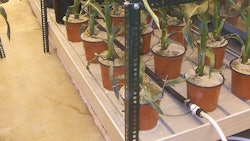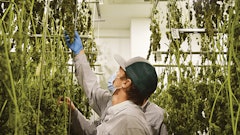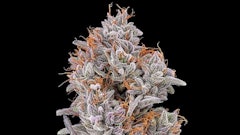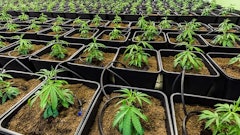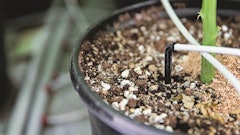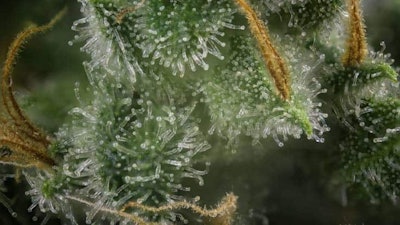

Black pepper, clove, honeysuckle, cinnamon, mint, lemongrass, and roses are all amazing aromas and flavors that make life so rich. Terpenes, comprised of hydrogen and carbon or hydrocarbons, are the building blocks of plant essential oils, and the aromatic compounds produced by many species of plants and other living organisms. Swallowtail butterflies and termites are just two examples of insects that produce terpenoids (which are oxygen-containing terpenes).
The volatile odors produced by hydrocarbons provide many benefits for plants, including preventing disease, protecting against heat and grazing animals, discouraging insects, attracting pollinators and beneficial pest predators, and more. Terpenes influence the taste, flavor, and pigments in plants and have a wide range of medicinal uses, including antifungal, antiviral, anticancer, anti-inflammatory, antihyperglycemic, antiparasitic, antioxidant, and antimicrobial. More importantly for the purposes of this article, they are responsible for the unique and distinct aromas, and, in some cases, part of the effects of cannabis.
A 2020 paper on cannabis terpenes and terpenoids titled “Terpenes/Terpenoids in Cannabis: Are They Important?” details that “myrcene is the smallest [yet] most prevalent terpene found in most varieties of cannabis. Chemotypes high in myrcene will result in a ‘couch lock’ effect (if a sample has over 0.5% myrcene), while chemotypes with low levels of myrcene (less than 0.5% myrcene) will produce a more energetic high. It is simply the amount of myrcene that is in the sample that dictates how you will be affected. Myrcene is simply the important monoterpene in the plant. Myrcene has antipsychotic, antioxidant, analgesic, anti-inflammatory, sedative, muscle relaxant, and anticancerogenic properties.”
The same study continues, “The most important sesquiterpene (a terpene with three isoterpene units per molecule) in the cannabis plant is probably ß-caryophyllene. It is a spicy terpene. This compound is the only terpene known to interact with the body’s endocannabinoid system (selectively binds to the CB2 receptor). Caryophyllene has gastroprotective, analgesic, anticancerogenic, antifungal, antibacterial, antidepressant, anti-inflammatory, antiproliferative, antioxidant, anxiolytic, analgesic, and neuroprotective effects. The presence of ß-caryophyllene in many essential oils might contribute strongly to their antiviral ability.”
Many factors can contribute to a plant’s terpene production, including weather conditions, geographical location, plant age, soil type, fertilizer used, and harvesting times and conditions. Certain regions of the U.S. are known for their optimal agricultural conditions that can be ideal for cannabis production, but areas with harsher conditions can also lead to strong terpene expression that many cannabis connoisseurs seek. Indoor growers (and, to an extent, greenhouse operators and outdoor farmers) also can create conditions that favor enhanced and nuanced terpene expression by manipulating environmental parameters, as well as considering genetics, medium type, fertilizer rates, and other production techniques. Here are six methods to boost your terpene production to produce vibrant, aromatic, and flavor-packed flower.
1. Genetic Selection: Genetics are a major factor in terpene expression. Cultivars have been bred for unique or pronounced terpene expression and there is no overlooking the value of starting with high-quality clones. Pheno-hunting seed stock can also produce some absolute winners. Working with a reputable breeder can help with finding the terpene profile and total terpene content that will please your customer base, but first examine what is hot in your market. (Cannabis Business Times’ "Sales Trends" department can be a good start.)
_fmt.png?auto=format%2Ccompress&fit=max&q=70&w=400)
Some customers are looking for an elevated level of a single dominant terpene, such as 1% or greater myrcene. Chemotypes (chemical phenotypes) with high myrcene content are immensely popular in many areas for all the benefits previously detailed, as well as for the fact that myrcene is one of the most well-known terpenes. Others are more interested in total terpene content and a diverse profile, while some might be hunting for rare and unusual terpenes. In medical markets, terpene choice may be dictated by medical needs.
In a 2020 paper titled “The Cannabis Terpenes,” the authors summarize several dominant cannabis terpenes by saying that beta-myrcene is known to have an analgesic effect by stimulating the release of endogenous opioids (the naturally produced neurotransmitters that bind with the brain’s opioid receptors), the fragrance of linalool could assist with anxiety through aromatherapy, and alpha- and beta-pinene “inhibits the activity of acetylcholinesterase in the brain. Therefore, it is claimed to aid memory and minimize cognitive dysfunction induced by THC intoxification.” Understanding your customer base and their needs and tastes can help you predict their palates.
From diesel, musky, and coffee tones to mango, sage, and florals, cannabis cultivars have an amazingly complex assortment of terpenes, so balance your genetic library to hit all the high notes with added focus on the strongest demands in your region.
2. Grow Medium: Growing in a rich, biodiverse “living” soil can translate to a nuanced and well-expressed terpene profile. At Galenas, we cultivate in a locally made, food-scrap compost-based potting soil with a robust microbiological profile and have terpene concentrations that regularly test over 4% with independent labs. Studies show that certain plant growth promoting rhizobacteria, or PGPRs, can enhance secondary metabolite production. Microbiologically abundant soils can often produce complex terpene profiles under optimal growing conditions. At Galenas, we bring some of the outdoor “terroir” inside our cultivation facility by working with a soilmaker that inoculates his compost with indigenous microorganisms from our region.
Find what works best for your genetics and, especially in more sterile mediums, consider inoculating with beneficial microbes. Trichoderma spp., for example, has been shown in many plant studies to increase root branching and shoot size, induce disease resistance, and improve plant nutrient uptake. A 2020 study titled “Ecological functions of Trichoderma spp. and their secondary metabolites in the rhizosphere: interactions with plants” states, “These fungi produce a number of secondary metabolites such as non-ribosomal peptides, terpenoids, pyrones, and indolic-derived compounds. In the rhizosphere, the exchange and recognition of signaling molecules by Trichoderma and plants may alter physiological and biochemical aspects in both.”
3. Fertilize Right: Regardless of your production method, it is important to avoid excessive fertilizer. Over-feeding crops can negatively impact secondary metabolites. Studies show that over-fertilizing with nitrogen, for example, can lead to a higher biomass, but lower secondary metabolite concentrations. Think of yield and resin content as a tradeoff to some extent, and try to find that sweet spot where they have both reached their fullest potential. For more information on proper fertilization rates, see “Put Your Fertilizer Program to the Test” here.
4. Inducing Stress: Introducing stress can increase cannabinoids and terpenes; however, indoor plants are generally dealing with multiple stressors related to an artificial environment. Factoring in all the compounding stresses indoor cannabis plants face, it is important to use inflicted stress carefully and methodically, and to apply only to plants that are in the most ideal environments throughout their entire life cycle.
_fmt.png?auto=format%2Ccompress&fit=max&q=70&w=400)
Manipulating light spectrum has been shown in various crops to influence secondary metabolites, though the research for cannabis is still in its early stages. One study from researchers at the University of Guelph postulated that “by supplementing with a subcanopy lighting with a rich green-light spectrum normally absorbed by some terpenes, that perhaps the plants up-regulated terpene biosynthesis to manage that environmental condition.” In other words, the researchers postulate that cannabis plants perhaps generate certain terpenes in response to the presence of green light, and that by increasing the amount of green light through sub-canopy lighting, secondary metabolite production might be enhanced.
Controlled drought stress to increase secondary metabolites can be very effective on cannabis plants, but it must be performed carefully. Light stress also can potentially lead to higher terpene expression, but may deliver detrimental consequences and the effects can differ widely among cultivars. Overuse of light or drought stress can negatively impact plant health, which can lead to many problems including low yield, pest issues, disease problems, and, ironically, decreased secondary metabolite production.
Salt stress training is another technique used for other crops, but more research needs to be conducted on its impact on cannabis plants.
5. Flower time/plant age: A 2016 study published in the Journal of Natural Products analyzed the terpene content of cannabis plants relative to plant age, and the research revealed some interesting findings. In this experiment, seven mother plants were selected from three distinct chemotypes, and 50 clones were taken from each and analyzed for cannabinoid and terpene content every week throughout their lifecycle.
_fmt.png?auto=format%2Ccompress&fit=max&q=70&w=400)
Although the results varied by chemotype, clear trends emerged as the total monoterpene and sesquiterpene content were calculated and graphed. Monoterpenes showed the same evolutionary pattern as analyzed cannabinoids, with a decrease during the first two weeks of veg and an increase toward the end of veg, as well as a slight decrease at the beginning of flower followed by a substantial increase relative to plant age in late-flower. The study ended at a plant age of 179 days with monoterpene content on the rise.
Sesquiterpenes had similar results until after the first few weeks of flower, when levels remained stable and did not exhibit the same increase as monoterpenes with plant age. Sesquiterpene content across the three chemovars generally peaked around day 165 but remained relatively high through the end of the 179-day analysis.
This study suggests that lengthening flowering time, even adding on an extra week when production allows, can contribute to higher total terpene content, particularly in the monoterpene-dominant cultivars.
6. Environmental Management: Last but surely not least, controlling your environmental parameters can likely affect your final terpene testing numbers. Terpenes can volatilize at high temperatures, so keeping your flowering rooms cool, especially in the last couple weeks prior to harvest, can help to preserve all the precious terpenes that your plants have synthesized. At Galenas, we have found that keeping our rooms in the mid-to-upper-60s in the days leading up to harvest has helped boost our terpene numbers. Continue using cool temps through your post-harvest processes to ensure you minimize terpene loss during drying, curing, trimming, and packaging.








